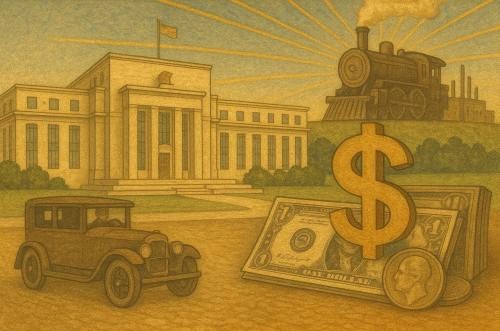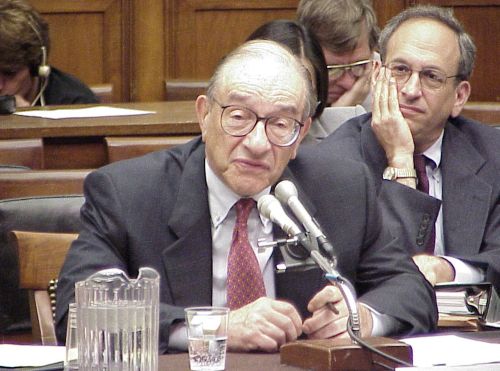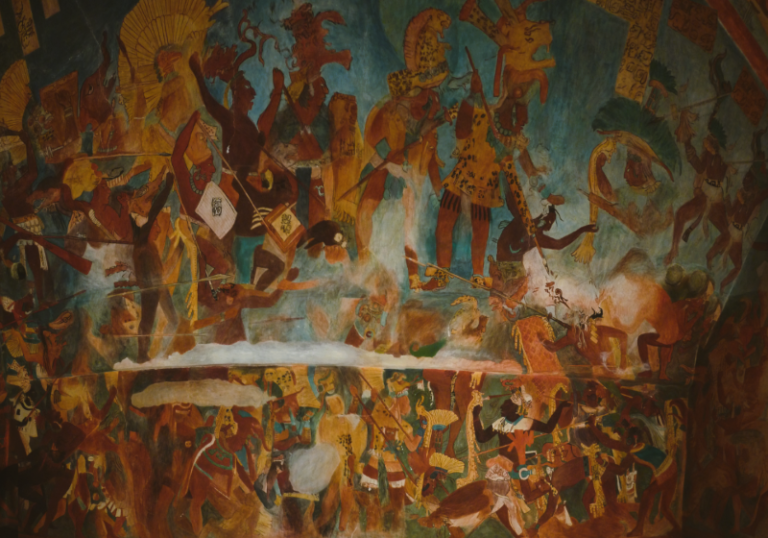

The Fed was designed to stabilize capitalism, not to replace it. In doing so, it has become both guardian and lightning rod, a symbol of technocratic expertise and democratic unease.

By Matthew A. McIntosh
Public Historian
Brewminate
Introduction: A New Experiment in Monetary Governance
The establishment of the Federal Reserve in 1913 represented both continuity and rupture in American history. For more than a century, the United States had struggled with the balance between centralized financial authority and the ideal of decentralized republican governance. The First and Second Banks of the United States had been short-lived experiments, undone by political distrust and populist resentment. By the early twentieth century, however, repeated banking panics revealed the inadequacy of ad hoc remedies.
The Federal Reserve Act of 1913 created not a singular bank but a system, twelve regional banks overseen by a central Board in Washington. It was designed to balance local autonomy with national coordination, public accountability with private expertise. Yet from its inception, the Fed embodied contradictions that would define its history: independence and oversight, flexibility and constraint, technocracy and politics. Its story since 1913 is the story of how the United States learned, often painfully, to manage modern money.
Origins: The Crisis of Confidence

The Panic of 1907 was the immediate catalyst for reform. When the New York financial system teetered on collapse, the absence of a central bank was starkly felt. It fell to J. P. Morgan, a private banker, to orchestrate a rescue by corralling other financiers to inject liquidity into failing institutions.1 The episode demonstrated both the fragility of American banking and the danger of relying on private magnates to stabilize the economy.
In response, Congress created the National Monetary Commission to study central banking models abroad. The resulting debates culminated in the Federal Reserve Act, signed into law by Woodrow Wilson in December 1913. Its architecture reflected compromise: regional banks for local sensitivities, a Federal Reserve Board for national oversight, and a mix of public and private influence to prevent domination by either Wall Street or Washington.2
The Federal Reserve in War and Depression
The Fed’s first major test came with the First World War. It managed the enormous task of financing the war effort, channeling credit to the Treasury, and stabilizing interest rates to support the Liberty Loan campaigns. This integration of monetary policy with national security set a precedent: in times of war, the central bank became an arm of state mobilization.3
The interwar years proved more ambiguous. In the 1920s, the Fed experimented with open market operations, discovering its capacity to influence credit conditions through the buying and selling of government securities. Yet the onset of the Great Depression revealed profound weaknesses. Historians and economists continue to debate whether the Fed’s contractionary policies in the early 1930s exacerbated the collapse. Milton Friedman and Anna Schwartz famously argued that the Fed’s failure to act aggressively turned a recession into a depression.4 Others stress the institutional novelty of the system and the reluctance of policymakers to overstep legal and political boundaries.
What is certain is that the Depression reshaped the Fed’s role. Reforms in the 1930s subordinated it more directly to the Treasury, binding monetary policy to fiscal priorities in an era of emergency governance. Independence, always fragile, nearly vanished under the pressure of crisis
War, Bretton Woods, and the Postwar Consensus

During the Second World War, the Fed once again subordinated itself to national needs, pegging interest rates to facilitate government borrowing. Only in 1951, with the Treasury-Federal Reserve Accord, did the central bank reclaim a measure of independence. The Accord is often remembered as the moment when the Fed began to assert its identity as a technocratic guardian of monetary stability.5
In the decades after 1945, the Fed operated within the broader Bretton Woods system, which tied currencies to the dollar and the dollar to gold. Its role was less flamboyant than in later years but no less critical. It managed liquidity, sustained growth, and supported the stability of an international system built on American economic preeminence. Fed policy became an anchor of the postwar consensus, even as inflationary pressures in the 1960s began to strain its credibility.
The Age of Inflation and the Rise of Volcker
The 1970s marked a turning point. With the collapse of Bretton Woods and the oil shocks of the decade, inflation surged to levels not seen in modern American history. The Fed, under Chairmen Arthur Burns and G. William Miller, struggled to contain it, often accused of yielding to political pressures from the Nixon and Carter administrations.
It was Paul Volcker, appointed by Carter in 1979, who redefined the institution. Determined to break inflationary expectations, Volcker implemented tight monetary policies, allowing interest rates to soar above 20 percent. The result was a deep recession in the early 1980s, with unemployment exceeding 10 percent, but inflation collapsed.6 Volcker’s actions cemented the Federal Reserve’s reputation for independence, demonstrating that the central bank could pursue unpopular policies in the name of long-term stability.
Greenspan and the Illusion of Mastery

Alan Greenspan, appointed in 1987, presided over one of the longest periods of economic growth in American history. He embodied the technocratic ideal of the Fed chair as “maestro,” steering markets with words as much as with policy levers. His tenure reinforced the perception that the Fed had mastered the art of stabilizing the economy through careful adjustments of interest rates.
Yet the illusion of mastery concealed vulnerabilities. Critics argue that Greenspan’s reluctance to regulate financial innovation contributed to the speculative excesses of the 1990s and 2000s. The dot-com bubble, the housing bubble, and the proliferation of complex derivatives exposed the limits of monetary policy when faced with systemic financial risk. Greenspan himself later admitted to a “flaw” in his faith that markets would regulate themselves.7
Crisis and Unconventional Policy
The 2008 financial crisis thrust the Fed into unprecedented territory. Under Ben Bernanke, the central bank deployed emergency lending facilities, slashed interest rates to near zero, and initiated quantitative easing, the large-scale purchase of government and mortgage-backed securities. These measures expanded the Fed’s balance sheet to unprecedented levels and blurred the line between monetary and fiscal policy.
The crisis revealed both the necessity and the danger of central bank activism. Supporters argued that without the Fed’s interventions, the financial system would have collapsed. Critics warned of moral hazard, inflationary risk, and an institution whose power now dwarfed its democratic accountability.
The COVID-19 pandemic renewed these debates. The Fed once again turned to massive asset purchases and emergency lending, underscoring its role as lender of last resort not just to banks but to entire sectors of the economy. Its policies sustained markets but reignited concerns about inequality, financialization, and the concentration of power in unelected hands.
Conclusion: Guardians and Controversies
Since 1913, the Federal Reserve has evolved from a fragile compromise into one of the most powerful institutions in American life. It has been blamed for deepening the Great Depression, credited with taming inflation, lauded for averting financial collapse, and criticized for exacerbating inequality. Its history reveals the central paradox of modern central banking: the attempt to insulate monetary policy from politics even as every decision carries profound political consequences.
The Fed was designed to stabilize capitalism, not to replace it. In doing so, it has become both guardian and lightning rod, a symbol of technocratic expertise and democratic unease. Its history since 1913 is not a story of steady mastery but of recurring crises that forced innovation, adaptation, and the constant renegotiation of its authority.
Appendix
Footnotes
- Robert F. Bruner and Sean D. Carr, The Panic of 1907: Lessons Learned from the Market’s Perfect Storm (Hoboken: John Wiley & Sons, 2007), 145–150.
- Allan H. Meltzer, A History of the Federal Reserve, Volume 1: 1913–1951 (Chicago: University of Chicago Press, 2003), 47–52.
- Margaret Myers, A Financial History of the United States (New York: Columbia University Press, 1970), 201–205.
- Milton Friedman and Anna Jacobson Schwartz, A Monetary History of the United States, 1867–1960 (Princeton: Princeton University Press, 1963), 299–304.
- Meltzer, A History of the Federal Reserve, Volume 1, 730–735.
- Paul Volcker and Toyoo Gyohten, Changing Fortunes: The World’s Money and the Threat to American Leadership (New York: Times Books, 1992), 145–150.
- Alan Greenspan, testimony before the House Committee on Oversight and Government Reform, October 23, 2008.
Bibliography
- Bruner, Robert F., and Sean D. Carr. The Panic of 1907: Lessons Learned from the Market’s Perfect Storm. Hoboken: John Wiley & Sons, 2007.
- Friedman, Milton, and Anna Jacobson Schwartz. A Monetary History of the United States, 1867–1960. Princeton: Princeton University Press, 1963.
- Greenspan, Alan. Testimony before the House Committee on Oversight and Government Reform, October 23, 2008.
- Meltzer, Allan H. A History of the Federal Reserve, Volume 1: 1913–1951. Chicago: University of Chicago Press, 2003.
- Myers, Margaret. A Financial History of the United States. New York: Columbia University Press, 1970.
- Volcker, Paul, and Toyoo Gyohten. Changing Fortunes: The World’s Money and the Threat to American Leadership. New York: Times Books, 1992.
Originally published by Brewminate, 09.04.2025, under the terms of a Creative Commons Attribution-NonCommercial-NoDerivatives 4.0 International license.


